Understanding Stickybumps: Key Insights for Kiteboarders

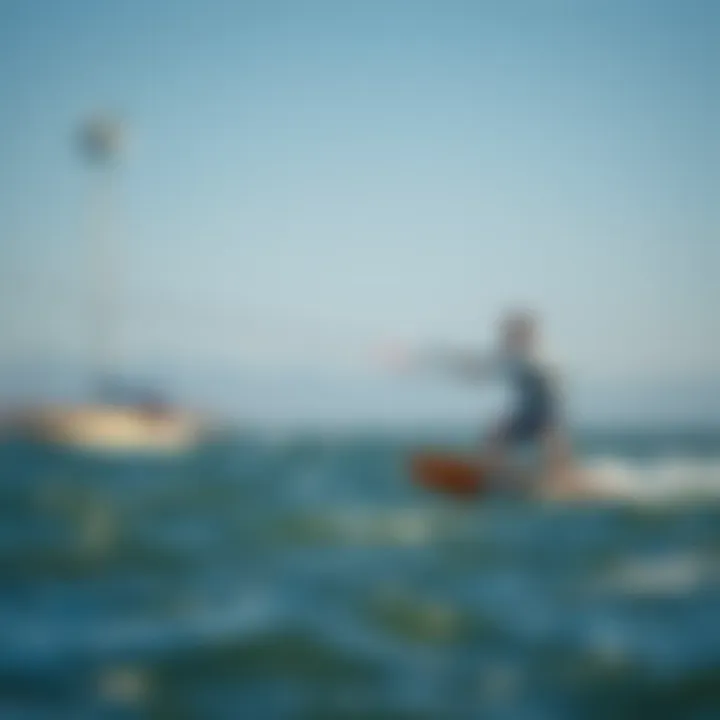
Intro
Kiteboarding is thrilling, a dance between wind and water, offering a unique sense of freedom for adventurers. However, one topic often lurks just beneath the surface: stickybumps. This term, while not commonly thrown around in casual conversations, refers to the challenges and benefits that can arise when a rider's board interacts with varying water conditions. When kiteboarding enthusiasts dive into the dynamics of stickybumps, they unearth a goldmine of insights into how these interactions can affect ride quality and performance.
Understanding stickybumps is not merely academic; it directly impacts a rider’s style and technique. By grasping the mechanics behind how certain bumps can enhance or hinder one’s ride, kiteboarders can better prepare themselves to manage these conditions. Not only does this knowledge refine one’s skills, but it also enhances enjoyment on the water.
In this guide, we will navigate through the essentials, breaking down the gear that can spell the difference when tackling stickybumps. We will also explore techniques and tips that cater to both beginners and seasoned enthusiasts, ensuring that every kiteboarder can optimize their experience and elevate their skills.
Gear and Equipment
Essential Kiteboarding Gear for Beginners
Starting out in kiteboarding can be both exciting and daunting. For beginners, having the right gear can make all the difference. Key items include:
- Kite: The heart of your setup. Look for a medium aspect ratio kite, which offers a balance of power and control, ideal for new riders.
- Board: A twin-tip board is popular among beginners due to its versatility and ease of use. Make sure to choose a size that matches your weight and the kite size for optimal performance.
- Harness: A comfortable harness helps to distribute the load and lets you sail without straining your body. Waist harnesses often provide more mobility; however, seat harnesses can offer better support.
- Safety Gear: This includes a helmet, impact vest, and sometimes, knee pads. Safety should always come first, even for those just dipping their toes into the sport.
Advanced Equipment for Experienced Riders
Once you've honed your skills and feel ready to push boundaries, it’s time to upgrade your gear. Experienced riders often look for specific features:
- High-Performance Kites: Advanced kites feature quick response rates and can handle stronger winds. Brands like North Kiteboarding and Slingshot offer models designed for performance.
- Specialized Boards: Advanced kiteboarders might consider directional boards for wave riding or specialized freestyle boards for tricks. The right board can drastically change how you interact with water bumps.
- Adjustable Harnesses: These allow for customization based on riding position and personal comfort preferences, essential for lengthy sessions or challenging maneuvers.
Optimal gear enables kiteboarders to harness the power of wind while confidently navigating through stickybumps. Choosing wisely here can set the foundation for a rewarding kiteboarding adventure.
Techniques and Tips
Basic Riding Techniques for Newbies
When starting out, it’s crucial to grasp a few fundamental riding techniques:
- Body Positioning: Keep your knees slightly bent and lean back against the power of the kite. This helps maintain balance.
- Edge Control: Use your edges to control speed and direction. Keeping weight towards the back of the board can help reduce stickybumps’ impact on your ride.
- Smooth Turns: As you gain confidence, practice smooth, gradual turns rather than sharp ones to avoid catching edges and getting flipped.
Expert Tricks to Elevate Your Skills
For those looking to enhance their riding style, consider these advanced techniques:
- Waves Riding: Mastering how to ride over varied water textures can dramatically improve your performance in sticky conditions. Look for the optimal angle and speed to glide over bumps.
- Air Tricks: Once comfortable, try small jumps. Approaching the lip of a wave or bump can yield exhilarating airtime.
- Wave Awareness: Learn to read the water’s surface. Understanding when to adjust your lines can help you better handle varying bumps and conditions.
By mastering these techniques, kiteboarders can turn any ride into an enjoyable experience while skillfully navigating stickybumps. Empower yourself with knowledge and gear; it’s the key to elevating your kiteboarding experience.
"The beauty of kiteboarding lies not just in the thrill of the ride itself, but in mastering the conditions that can elevate it."
For further insights and tips, check out Kiteboarding.org or Reddit Kiteboarding Community for discussions and personal experiences.
Achieving mastery of stickybumps will not just make you a better rider but will also deepen your appreciation for the complexities of kiteboarding.
Defining Stickybumps
Understanding stickybumps essentially lays the groundwork for kiteboard enthusiasts to navigate the nuances of this intriguing phenomenon on the water. Stickybumps can be frustrating for some riders, but comprehending what they truly are offers a straightforward path to enhancing performance. The term refers to the feeling of excessive drag or grip when a rider's board makes contact with the water, leading to less fluid motion and reduced speed. This can occur due to numerous factors, such as water conditions, board design, and riding technique.
The importance of defining stickybumps lies in its direct correlation to the rider's experience. Knowing how to identify and work with stickybumps can turn a challenging situation into an opportune moment for improvement. After all, with the right understanding, kiteboarders can learn to adapt their skills, optimize their gear, or select conditions that minimize the issue altogether. The ability to manage this aspect of riding ultimately contributes to a smoother experience on the water, elevating both performance and enjoyment.
Understanding the Term
When diving into the concept of stickybumps, it's critical to define the term clearly. Stickybumps refer to the resistance felt at the board's base during movement across the water. This sensation can be analogized to trying to glide across a sticky surface – the board may stick or slow down rather than effortlessly slicing through the surface. Often, this sensation is intensified in choppy or turbulent waters, where the unpredictable nature of the surface exacerbates the effects.
Colloquially, many riders might describe it as feeling like they’re “dragging an anchor.” Getting familiar with the terminology and nuances associated with stickybumps provides riders with a solid foundation to not just cope but thrive while kiteboarding.
Origin and Evolution of Stickybumps
The concept of stickybumps isn't new; its origin runs parallel to the sport itself. Early kiteboarders quickly noticed how different water conditions affected their boards' performance. It led to a growing understanding that not all riding conditions are created equal. Initially treated as an unavoidable nuisance, stickybumps sparked innovation in board design and riding techniques.
As the kiteboarding community evolved, so did the approaches to dealing with this issue. Boards are now meticulously engineered to minimize drag and enhance control, featuring specialized fin setups and hull designs. Companies continually innovate, incorporating modern materials and hydrodynamic principles to create equipment that offsets the negative impacts of stickybumps.
Moreover, online forums and community discussions have fostered a wealth of knowledge-sharing around stickybumps. Riders now discuss adaptable techniques that help them navigate sticky conditions, turning what was once merely a challenge into an area for improvement and experimentation.
As we move forward in this exploration of stickybumps, it's essential to keep in mind that staying informed is a rider's best bet. By knowing the history and evolution of stickybumps, enthusiasts can appreciate their journey and potentially shape its future.
The Science Behind Stickybumps
Understanding the science behind stickybumps is critical for kiteboard enthusiasts looking to enhance their performance on the water. Stickybumps—the points of tactile grip between the kiteboard and water—are not just random occurences; there is a profound physics at play that can drastically influence a rider's experience. By exploring the nuances of how water and board interact, and considering the board’s shape and size, kiteboarders can take informed steps to mitigate or leverage these bumps to their advantage.


Physics of Water Interaction
At its core, the physics of water interaction sheds light on what happens when a kiteboard skims across the surface of the water. As a kiteboard travels, the laws of fluid dynamics dictate how water molecules behave in response to the movement of the board. The principles governing viscosity, surface tension, and turbulence come into play, creating what might be termed a symbiotic relationship between the rider and the water.
When a board gains speed, it generally experiences a lift, thanks to the shape of its hull. This lift can result in less resistance, allowing for a smoother ride. However, stickybumps can disrupt this flow. For example, small changes in water temperature or underlying substrate can change the way water adheres to the board’s surface—metaphorically like trying to slide on ice only to hit a patch of mud.
Liquid’s density also affects the board’s performance. Warmer water tends to be less viscous than cold water, leading to a different feel underfoot. If the water is choppy or has debris, it can create unexpected bumps. Understanding these physical properties allows riders not only to anticipate changes as they ride but also adapt their techniques accordingly.
"Mastering the physics of water interaction is akin to understanding the notes in a symphony; it allows you to perform harmoniously instead of clashing with the elements."
Impact of Board Shape and Size
The shape and size of a kiteboard significantly influence how it interacts with stickybumps. A board with a narrower profile might cut through choppy water with ease but could struggle against rough patches. On the other hand, a wider board can distribute weight differently, giving it a stable ride but potentially slowing down speed during quick maneuvers.
When considering board size, riders often find themselves weighing the pros and cons: larger boards may offer increased buoyancy and stability, but at the expense of agility. Conversely, a smaller board allows for quick turns and tighter carving but can feel like a lively fish out of water if the conditions aren’t just right.
The rocker of the board—its upward curve—also plays a significant role. A pronounced rocker can assist in maintaining lift above rough waves but may contribute to losing some grip during those tricky transitional moments. A flat-bottomed board, while excellent in flat water, may encounter difficulties when faced with stickybumps, as its contact area with the water changes more dramatically.
Ultimately, the impact of board shape and size on stickybumps cannot be overstated. The choice of what to ride can be as critical as how well one understands the implications of their equipment on the water. Keeping an open mind, riders can experiment with different configurations and find the right balance that maximizes their performance.
- Remember:
- Wider boards lift more easily but can slow agility.
- Narrow boards are quicker but may not handle bumps well.
- Understand your rocker; adjust to conditions.
The interplay between physics and practical riding ultimately shapes how one experiences stickybumps, offering avenues for improvement and strategies for adaptation.
Stickybumps and Performance
Stickybumps play a crucial role in kiteboarding performance, acting as the fine line between fluid maneuvers and awkward tumbles. The phenomenon of stickybumps directly influences both speed and rider control, presenting both benefits and challenges.
Effects on Speed and Agility
When kiteboarders talk about stickybumps, what often comes to mind is the exhilarating rush of speed accentuated by wave conditions. The unique texture that stickybumps create on the water can foster an impressive boost in speed for experienced riders. On smoother water, the board glides freely, but stickybumps can alter this dynamic, allowing for a more responsive ride.
"Mastering the nuances of your board's interaction with stickybumps can cut seconds off your time during competitions."
This change in the water’s surface can, however, become a double-edged sword. While they can enhance agility by enabling quicker turns and sharper maneuvers, consistent exposure to a bumpy surface may lead to instability if not handled correctly. Top riders often adjust their technique, using the waves to leverage speed rather than resist it.
- Speed enhancement factors:
- Considerations to maintain agility:
- Optimal wind conditions
- Rider skill and technique
- Type of board used
- Positioning on the board
- Weight distribution during maneuvers
- Quick adjustments to foot placements
Rider Control and Stability
Control is the name of the game when it comes to stickybumps. The way a kiteboarder interacts with the water’s surface texture can either enhance their riding experience or present significant difficulties. When stickybumps are involved, the importance of body positioning cannot be overstated. Maintaining a low center of gravity helps in absorbing shocks from waves and maintaining stability.
The implications of erratic bumpy surfaces extend beyond mere balance; they can affect how a rider navigates through winds and currents. A well-timed adjustment in stance can offer a distinctive edge, allowing a rider to carve through waves with finesse.
Riders should pay close attention to these elements:
- Body position essentials:
- Stability maintenance strategies:
- Knees slightly bent to absorb variations
- Shoulders aligned with board direction for better control
- Eyes focused ahead to predict and react to waves
- Consistent practice in variable water conditions
- Utilizing knee and foot straps effectively
- Developing muscle memory for quick adaptations
The interplay of stickybumps and rider control hinges on experience and adaptability. As riders spend more time on the water, they can anticipate changes and adjust their approach, enhancing both performance and enjoyment. Performance on the water isn't just about skill—it's about understanding the nuances presented by the environment.
Identifying Stickybumps
Recognizing stickybumps while kiteboarding is crucial for improving both safety and performance on the water. Understanding how to identify these bumps can enhance the overall riding experience and allow for better control over the board. When riders are able to spot the telltale signs of stickybumps, they can adjust their techniques and equipment accordingly, ultimately leading to a more enjoyable and efficient ride.
Visual Indicators
The visual aspects of stickybumps are usually related to changes in the water surface. Riders can be on the lookout for certain indicators:
- Surface Texture Changes: Pay attention to the rippling or choppy nature of the water. A rough patch might mean stickybumps are present.
- Foam and Whitecaps: If you observe foamy patches or whitecaps consistently forming in a particular area, there’s a good chance you’re encountering stickybumps.
- Color Variation: Darker areas of the water often indicate more depth or obstacles below the surface that might be causing the sticky sensation.
These visual markers can provide immediate clues about the water conditions ahead. Being adept at noticing such details helps in making quick decisions while riding, which can be crucial for avoiding falls or mishaps.
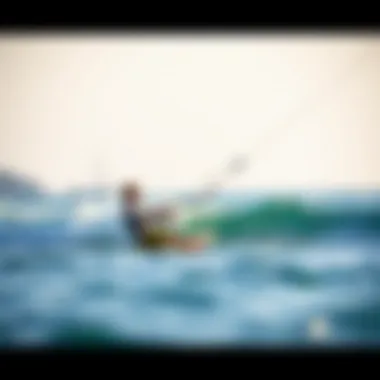
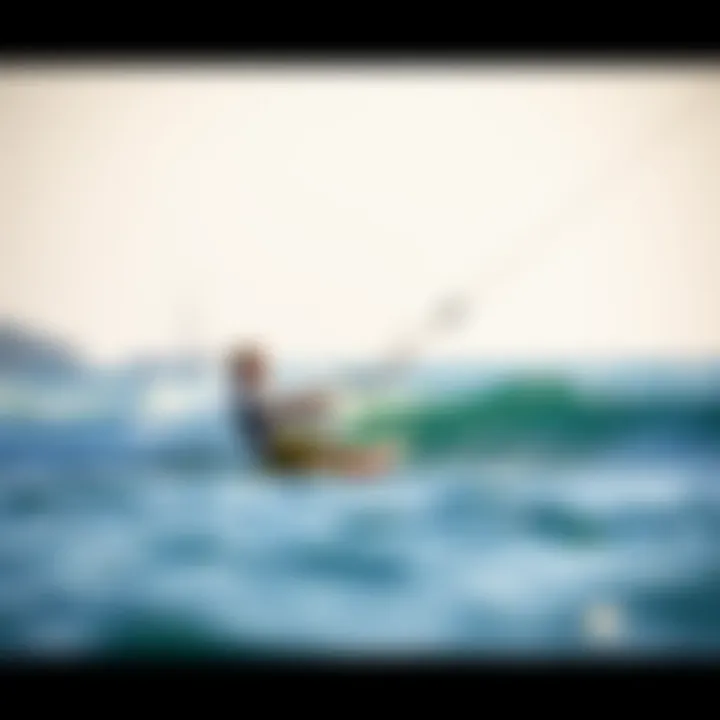
Physical Sensations While Riding
The feeling when riding over stickybumps can vary but often includes specific sensations that indicate their presence. Riders may experience:
- Increased Drag: A sudden feeling of resistance might indicate stickybumps have grabbed hold of the board, making it harder to glide smoothly.
- Altered Control: The board may feel less responsive when you hit a sticky bump, which can lead to unexpected movements. This sensation should alert you to adjust your stance.
- Impact on Balance: Many riders have reported that a sudden jolt or shift in momentum, particularly when the water conditions are bumpy, can throw off their balance, forcing them to compensate quickly.
By tuning into these physical sensations, a kiteboarder can relay important information back to their technique. It enables the rider to adapt on the fly, ensuring better stability and control over their movements.
"Being aware of your surroundings is half the battle. Recognizing these cues simply makes everything else smoother."
Incorporating these insights into practice not only betters individual performance but also promotes a safer kiteboarding activity. An engaged approach allows riders to react proactively, creating a more fulfilling kiteboarding experience.
Managing Stickybumps
Understanding how to effectively manage stickybumps is crucial for anyone venturing into kiteboarding. Stickybumps can be a double-edged sword; they can enhance or hinder your performance depending on how well you adapt to them. By improving your skills in this area, you’ll not only enjoy your time on the water more but also maximize your potential for speed and maneuverability.
Riders need to grasp the nuances of stickybumps, as these features can significantly impact each session. Frequent kiteboarders might recognize that these bumps vary depending on water conditions and weather patterns. Successfully navigating stickybumps can lead to a more thrilling ride, allowing you to harness every opportunity they present. Factors such as rider experience, board design, and environmental changes all play a role in how stickybumps affect performance.
Adaptation Techniques for Riders
Implementing useful adaptation techniques is essential when dealing with stickybumps. One primary method is to adjust your riding stance. A lower, more centered position enhances stability and balance, allowing for better control over the board. Shifting your weight to the rear foot can help you manage the forces created by the bumps, providing traction when needed most.
Moreover, you might consider modifying your approach to turns. Tightening your body and looking ahead are fundamental skills that can help in anticipating changes in the water surface. As you develop these techniques, don’t hesitate to practice them gradually in flatter conditions before heading into more challenging waters.
- Here are a few adaptation techniques to consider:
- Shift Weight: Always keep your weight shifting towards the back of the board during transitions over bumps.
- Flexible Knees: Maintain flexible knees to soak up chop and maintain stability as you ride.
- Proper Stance: A staggered or duck stance can provide better leverage and control when jolts occur.
Equipment Adjustments
Your equipment plays a major role in how well you manage stickybumps. Small tweaks can lead to substantial improvements in how you handle these bumps while kiteboarding. The choice of fin size and type, for instance, deserves careful consideration. Fins that are larger tend to provide better grip, allowing for more efficient navigation through sticky conditions.
Another factor to look into is your kite settings. Lowering your kite setup can increase your control at the expense of top-end speed, but it can be worth it when faced with a choppy surface. Additionally, checking your lines regularly ensures you’ve got the right tension, which affects responsiveness and handling.
- Common equipment adjustments include:
- Fin Selection: Choose larger fins for enhanced grip on bumpy water.
- Kite Height: Adjust your kite to ensure it’s low enough for control without sacrificing too much speed.
- Line Check: Regularly inspect and adjust your lines for optimal performance during shifts in conditions.
Ultimately, managing stickybumps should not deter you but rather enhance your kiteboarding experience. With the right techniques and equipment, you can turn potential obstacles into valuable learning moments.
Experiential Insights from Advanced Riders
Gathering insights from experienced kiteboarders is vital when trying to grasp the nuances of stickybumps. These riders have often faced the unpredictable nature of waterways and have gathered a wealth of experience over the years. Their stories not only serve as compelling narratives but also serve as practical guides for newbies and seasoned kiteboarders alike.
From their anecdotes, one can comprehend the advantages offered by stickybumps but also how they can pose challenges if not properly managed. The firsthand experiences lead to a deeper understanding of materials, techniques, and even mental readiness when tackling the conditions that produce stickybumps.
Case Studies and Anecdotes
Many elite kiteboarders have had unique experiences in varying water conditions that led to the discovery and management of stickybumps. For instance, consider an athlete who faced a challenging day on a gusty wind day at a popular spot like Cape Hatteras. That day, the combination of wind and the shallow, turbulent waters resulted in an abundance of stickybumps. While this rider initially felt overwhelmed, they adapted quickly, utilizing their gear to skim over the undulating surface instead of battling against it.
This anecdote highlights not only the adaptability that comes with experience but also how observing conditions and making real-time equipment adjustments can change the game entirely. In field conditions, it's not enough to rely solely on theoretical knowledge; the capacity to read the water and react accordingly is what makes a rider proficient.
Furthermore, another rider shared how the shape of their board altered their interaction with stickybumps. They had originally used a wide board that was slow on takeoffs but didn’t handle bumps well. After switching to a narrower design, they found that the new board glided more smoothly, making it easier to maintain speed and control, even when the water was less than perfect.
Lessons Learned from Stickybumps
The insights gained from stickybumps extend well beyond the immediate riding experience. They highlight critical lessons about resilience and adaptability. Advanced riders often emphasize the importance of mental clarity and awareness of one's environment. Here are some key takeaways:
- Understanding Personal Limits: One common lesson among veteran riders is recognizing how their skills align with varying conditions. They often learned the hard way that pushing beyond comfort zones without a plan can lead to falls or injuries.
- Gear Matters: The type of equipment you choose makes a significant difference in handling stickybumps. Many experts recommend trying different board sizes and constructions before settling on what works best for one's personal style and the water conditions.
- Practice Makes Perfect: Advanced riders frequently advise newcomers to practice in diverse scenarios. This not only builds confidence but also helps to understand how stickybumps can differ depending on local conditions and tidal factors.
This synthesis of lessons learned aids those in the kiteboarding community, whether new or seasoned, in navigating the waters more effectively. Through the stories and shared experiences of others, kiteboarders can arm themselves with the collective knowledge necessary to confront the various challenges posed by stickybumps.
Environmental Considerations
Understanding the environment in which kiteboarding takes place is crucial for appreciating the dynamics of stickybumps. Kiteboarders are often at the mercy of natural elements, which can dramatically influence water conditions and performance. By examining the environmental factors, one can gain insights into how to optimize their riding experience and manage stickybumps effectively.
Water Conditions and Stickybumps
Water conditions play a pivotal role in the formation and characteristics of stickybumps. Factors such as wave size, current strength, and the body's surface texture contribute significantly to the experience of a kiteboarder. Freshly churned waters, for instance, can create conditions where the surface feels sticky, as if a thin layer of resistance is acting against the board.
- Wave Size: Smaller, choppier waves can create a bumpy surface that can either aid or hinder speed and agility. Experienced riders tend to find these conditions exhausting, but learning to harness them can lead to significant performance improvements.
- Current Strength: In stronger currents, the water flow can change the way stickybumps are felt. A surfboard may feel faster in a current racing out but can become cumbersome when trying to navigate back in.
- Surface Texture: Not all waters are equally inviting. For instance, sandy or muddy bottoms create a different sticky feeling compared to rocky or coral environments. The key is to adapt, recognizing the impact these variables can have on control.
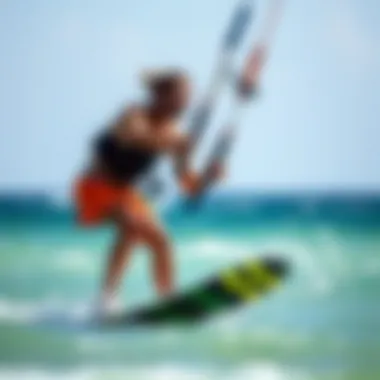
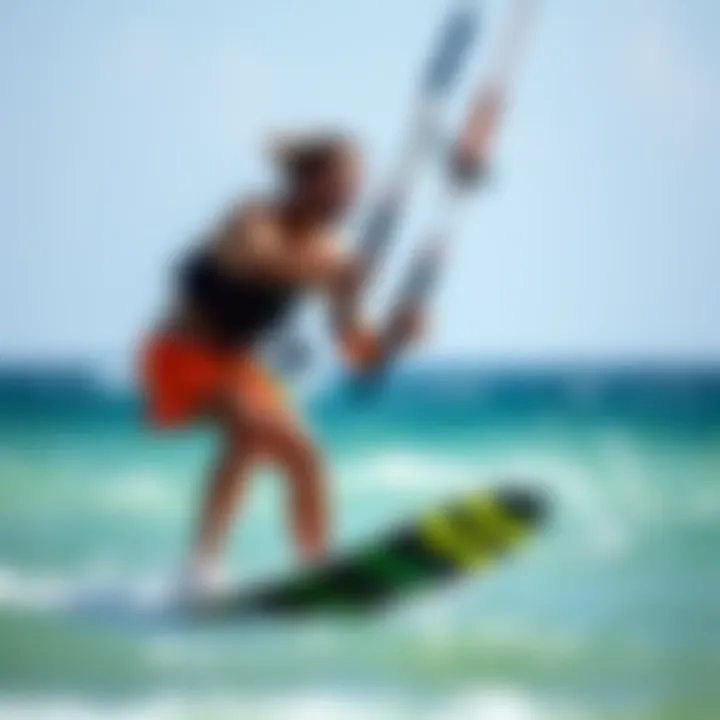
Anecdotally, many riders often remark that their best experiences come on days when the water is just right:
"Nothing beats the feeling of gliding over those perfect little bumps on a sunny day. It’s like dancing on water."
By being mindful of these elements, riders can prepare themselves accordingly—whether that's adjusting their equipment, tweaking their riding style, or simply enhancing their awareness of the water beneath them.
Impact of Weather Variations
Weather conditions further complicate the understanding of stickybumps. Factors such as wind strength and direction, temperature, and overall climate can have tangible effects on both the water surface and the rider’s experience.
- Wind Strength and Direction: Changes in wind can influence the water's surface tension, causing variations in how sticky or fluid the bumps may feel. A strong onshore breeze can add surface texture, creating a more vital bumpy ride, whereas a calm day might smooth things out.
- Temperature: Colder water often feels more rigid, which can lead to a different sensation when navigating stickybumps. Conversely, warmer weather can create a more forgiving surface that allows for easier maneuvers.
- Climate Events: Sudden weather changes, such as storms, can drastically restructure the water surface. A tempest might stir up the ocean floor, creating irregular bumps that can surprise even the most skilled riders.
By paying attention to these weather variables, kiteboarders can harness the conditions to their advantage, ultimately leading to more enjoyable sessions and improved skill levels.
In summary, environmental considerations provide a backdrop of understanding for stickybumps, revealing their intricate relationship with water conditions and weather variations. Embracing these factors not only helps in mastering the art of kiteboarding but also encourages a deeper appreciation for the natural world, its whims, and how they shape our riding experience.
The Future of Stickybumps
As kiteboarding continues to evolve, the focus on stickybumps is bound to increase. These unique water conditions not only impact performance but shape the entire experience of riding. Understanding where the future of stickybumps is heading can provide kiteboard enthusiasts with an edge in both skills and equipment choices. With advancements in technology and the constant adaptation of techniques, the landscape of kiteboarding is changing at an impressive pace.
Technological Innovations in Kiteboarding
The kiteboarding industry has seen remarkable transformations in recent years, much of it driven by technology. Innovations in materials, designs, and performance metrics play a vital role in how riders tackle stickybumps. One area of significant progress includes the development of hydrophobic coatings that repel water on equipment surfaces. This enhancement helps reduce the effects of stickybumps, allowing for smoother navigation through variable water conditions.
Furthermore, the introduction of smart technology has begun to infiltrate kiteboarding gear. Sensors embedded in boards and kites can analyze performance in real time and provide insights to the rider. This feedback can be instrumental in adjusting to changing stickybumps, leading to enhanced rideability. Riders can adjust their approach, making instantaneous changes to speed or style based on immediate conditions observed by these technologies.
Another exciting evolution is the expansion of eco-friendly materials. More brands are prioritizing sustainability, meaning that kiteboards and kites are being made using recyclable or less harmful materials. These innovations not only contribute positively to the environment but often lead to improved performance characteristics as well, reducing drag and enhancing flow across sticky surfaces.
Evolving Techniques and Strategies
As kiteboard enthusiasts navigate through quirkier water conditions caused by stickybumps, they are also developing new strategies. Riders have been increasingly collaborating in online forums and communities to share their experiences and techniques. Some specific methods are starting to gain traction among the passionate kiteboarding community.
- Spotting Patterns: The ability to recognize the specific shapes of stickybumps plays a pivotal role. By studying the formations, riders can anticipate how a bump may affect their trajectory.
- Adjusting Riding Styles: Different conditions call for varied riding styles. Some riders are now incorporating more carving maneuvers or slow-speed tricks to maintain control. This adaptation is crucial in moments where stickiness surfaces unexpectedly.
- Team Riding: Many kiteboarders are realizing the benefits of riding in pairs or groups. They help spot each other’s reactions to stickybumps, sharing useful insights and adapting techniques on the fly.
"Innovation in kiteboarding isn't just about speed or tricks—it's about understanding our waters better and mastering every condition we face."
As kiteboarders pivot towards this future, they must keep an eye on how both their gear and techniques will influence their riding experience on dynamic waters. For more information on kiteboarding practices and discussions, visit resources like Reddit and Wikipedia for comprehensive articles and community insights.
Community Perspectives on Stickybumps
In the world of kiteboarding, the experience often transcends beyond just the physical thrill of riding waves. Community plays a pivotal role, especially when it comes to understanding and managing stickybumps. These discussions and collective experiences can illuminate paths for improved riding techniques and better equipment choices. Within this section, we delve into various insights, both from everyday riders and seasoned professionals, shedding light on the broader implications of stickybumps and how they relate to the kiteboarding community.
Insights from Online Forums
Online forums serve as treasure troves of information for kiteboards enthusiasts. These platforms bring together a multitude of perspectives from people who ride in various conditions and locales. One of the greatest strengths of online discussions is their ability to provide real-time feedback and lived experiences. Here are key points often raised in these forums:
- Local Knowledge: Members frequently share specific details about stickybumps in their regions, addressing factors like water temperature, wind direction, and seasonal changes. For instance, someone riding in Florida might highlight that the stickybumps they face differ significantly from those encountered in the choppy waters of Hawaii.
- Technique Sharing: Riders can exchange tips about the best maneuvers to mitigate the effects of stickybumps, revealing tricks that wouldn’t be as easily shared in a formal setting. Whether it’s the optimal stance or foot placement on the board, discussions like these can demystify what often feels like a personal struggle.
- Product Reviews: Tied to managing stickybumps are the varying types of boards and their characteristics. Users often post reviews of specific brands like Liquid Force or North Kiteboarding, discussing board shapes, sizes, and features that help tackle the stickybumps issue effectively. These reviews provide anecdotal evidence that can guide fellow riders when considering new equipment.
Engaging with these online communities significantly enhances one’s understanding of stickybumps. As kiteboarders relay stories about overcoming specific conditions or share gear recommendations, it contributes to an ever-evolving narrative about how to anticipate and adapt to this natural phenomenon.
Gathering Expert Opinions
Turning to kiteboarding experts offers an additional layer of understanding regarding stickybumps. Professionals such as instructors and competitive riders often provide insights grounded in extensive experience and research. Their opinions are invaluable resources for enthusiasts looking to deepen their kiteboarding knowledge. Below are some noteworthy insights commonly discussed by these experts:
- Scientific Foundations: Experts frequently emphasize the importance of understanding fluid dynamics. The way water interacts with the board directly influences the onset of stickybumps and performance. For example, an experienced instructor may explain how specific riding styles and board designs alter water flow, thereby impacting how stickybumps form and are navigated.
- Training and Techniques: Professional riders advocate for training that incorporates handling stickybumps. Many suggest tailored drills that help riders learn to counter the effects of these bumps effectively. Techniques focused on weight distribution and balance can drastically improve control when riders encounter sticky situations.
- Community Workshops: There is a growing trend of workshops and training camps led by experts aimed at discussing stickybumps in depth. These gatherings are not only a way to learn but also to foster connections among riders. They usually involve hands-on sessions, allowing participants to experience the effects of stickybumps firsthand while receiving immediate feedback from seasoned professionals.
By harnessing the combined wisdom from online forums and expert opinions, kiteboarders can significantly enhance their understanding and management of stickybumps. The different perspectives enrich the community’s collective knowledge and ultimately support even the most seasoned riders in navigating these complexities. The synergy between shared experiences and expert guidance is what keeps the kiteboarding community thriving.
Summary and Reflections
In the context of kiteboarding, understanding stickybumps is not just for the curious; it's crucial for enhancing one’s riding experience. Throughout this article, the discussion centered around various facets of stickybumps, each illuminating aspects integral to performance on the water. The reflections drawn here aim to encapsulate the essence of what stickybumps mean to both novice kiteboarders and seasoned surfers alike.
Stickybumps, as defined, relate to the varying conditions of water, surface texture, and the interaction of equipment. Grasping these intricacies can aid in fine-tuning skills, allowing for improved speed, agility, and control while riding. The importance of this understanding cannot be overstated, as it directly correlates to how effectively riders can adapt and respond to their surroundings.
Among the key elements discussed, the physics behind how stickybumps interact with board shape was foundational. Performance hinges on both the environmental factors and rider technique. This article's insights empower readers to maneuver confidently, making it evident that even the most experienced kiteboarder can benefit from continously refining their understanding of stickybumps.
Additionally, the behavioral and experiential insights offered by advanced riders provide a grounded perspective on real-world applications. This community wisdom is invaluable for guiding newcomers and refreshing knowledge for veterans. The invite for ongoing exploration through environmental considerations and technological advancements ensures that kiteboarding remains an evolving sport.
Key Takeaways
- Stickybumps fundamentally alter riding dynamics; understanding them can enhance performance.
- Physics and board design interplay significantly affects how riders adapt to water conditions.
- Practical insights from the community highlight the necessity of shared experiences in learning.
Encouraging Ongoing Exploration
Encouraging ongoing exploration into stickybumps goes beyond mere curiosity; it fosters a culture of learning among kiteboarding enthusiasts. Engaging with online forums, actively participating in workshops or meetups, and experimenting with different equipment all contribute to a deeper understanding of this nuanced aspect of the sport.
- Participate in Community Discussions: Platforms like Reddit and Facebook host numerous groups where fellow riders share experiences and tips about managing stickybumps.
- Attend Workshops and Training Sessions: Opportunities to learn from experienced kiteboarders or instructors help refine techniques and enhance skills.
- Experiment with Equipment: Testing different boards, fins, or setups in varying conditions keeps the learning experience dynamic and engaging.
By continually revisiting and exploring the dynamics of stickybumps, kiteboarders not only improve their performance but also enjoy the very essence of the sport, thriving in the ever-changing conditions of the water.















